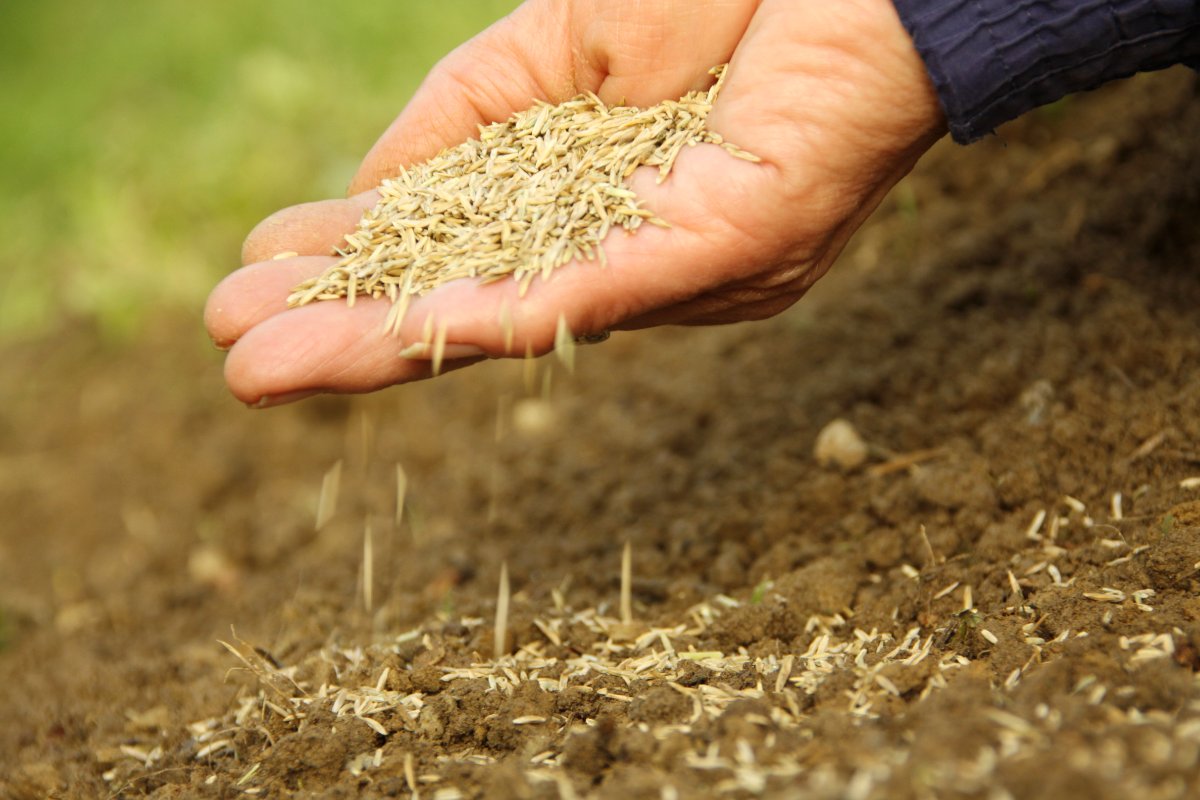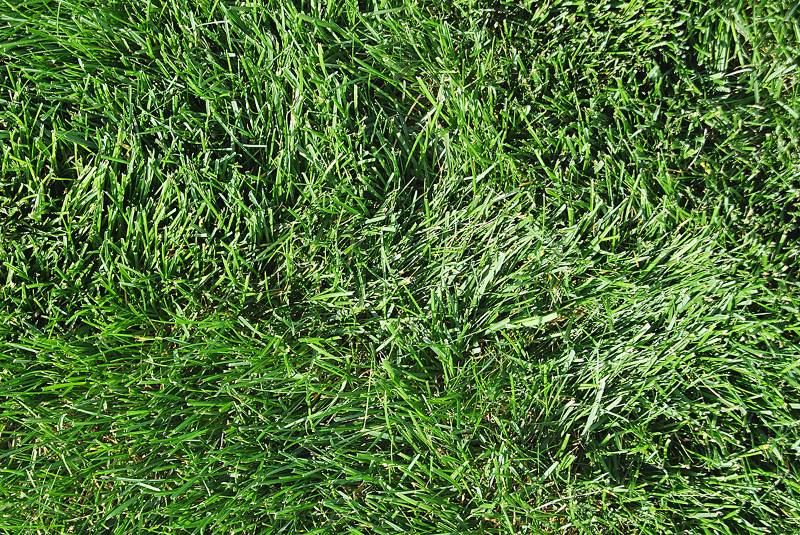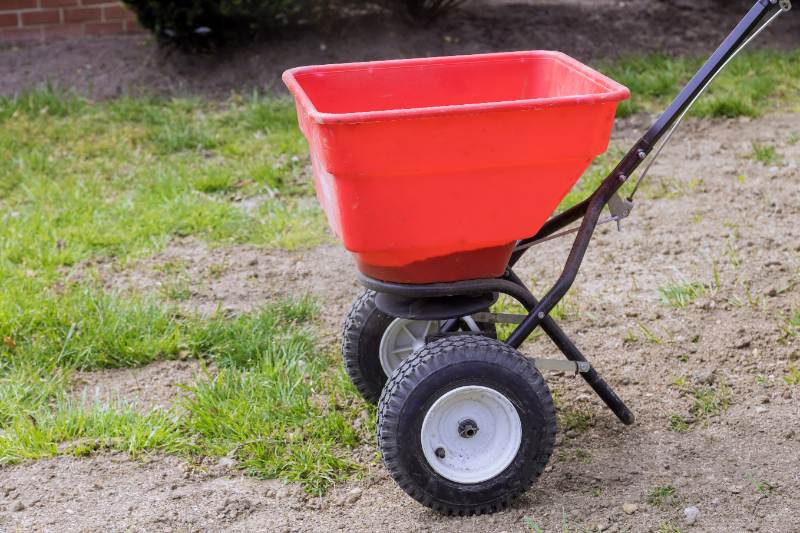
Want a lawn with a stunning blue-green color? Planting Kentucky bluegrass seed is the way to go. Start by preparing the soil, evenly spreading the seeds, and watering thoroughly.
Kentucky bluegrass thrives in cooler climates, providing a dense, vibrant lawn that’s both beautiful and hardy. With the right care and planting technique, your yard will be the envy of the neighborhood.
| Project difficulty: Beginner Estimated time to complete: Around 1-2 days, not including lead time to get the results of your soil test. Project cost: Expect to pay between $168 to $278 for 1 bag of grass seed, 1 bag of starter fertilizer, a new spreader, and a 4-hour tiller rental. The cost to hire a pro to seed your lawn runs between $0.09 and $0.15 per square foot. The most important cost factor is your lawn size. |
What is Kentucky Bluegrass?
Kentucky bluegrass is a cool-season grass known for its fine texture, rich blue-green color, and dense, lush growth. Originally native to Europe and North Asia, it has become a favorite in the northern U.S. for lawns, sports fields, and parks due to its ability to form a thick, carpet-like turf.
This grass thrives in the top half of the country and performs best in well-drained soils with plenty of sunlight. Its grass blades are soft and comfortable underfoot, making it an ideal choice for family yards and recreational areas. Additionally, Kentucky bluegrass can quickly recover from wear and tear.
See Related: 6 Best Grasses to Walk On Barefoot
Step-by-Step Guide to Planting Kentucky Bluegrass

Planting Kentucky bluegrass is an easy process that can yield a lush, blue-green lawn. Follow these steps to ensure successful planting and growth:
Step 1: Test the Soil
Knowing the condition of your soil is the first step to prepare your lawn for planting any grass. Prepare a soil sample and take it to your local Extension office, or use an at-home soil test kit to learn your soil’s pH and key nutrient levels.
See Related:
Step 2: Choose the Right Time
The best time to plant Kentucky bluegrass seed is late summer to early fall, when temperatures are cooler and there’s more rainfall. Seeding around Labor Day works well. Spring planting is possible but will require more attention to watering and weed control.
See Related: When is the Best Time to Plant Grass Seed?
Step 3: Prepare the Soil
Begin by clearing the area of debris, rocks, and weeds. Loosen the top 6 to 8 inches of soil with a tiller (or rake, for small areas), and mix in compost or a high-quality soil amendment to improve soil fertility and drainage. If your soil test recommended pH or fertility adjustments, add those amendments now.
Pro Tip: Most newly seeded lawns benefit from a high-phosphorus starter fertilizer to support early root development. Follow the recommended rates on the fertilizer package for best results.
Step 4: Spread the Grass Seeds

Use a drop seeder to evenly distribute the seeds at a rate of 2 to 3 pounds per 1,000 square feet. To ensure even coverage, spread half of the seeds in one direction and the other half perpendicular to the first pass.
See Related: How to Plant Grass Seed
Step 5: Lightly Rake and Roll
Lightly rake the soil to cover the seeds until only 10% to 15% are showing. Then, use a lawn roller (optional) to press the seeds gently into the soil to ensure good seed-to-soil contact.
Step 6: Water Thoroughly
Water the seeded area immediately after planting, soaking the soil to a depth of 4 to 6 inches. After this initial soak, keep the soil consistently moist, but not soggy. In the beginning, water lightly and frequently, 1-3 times a day, gradually reducing the frequency as the grass starts to establish.
Kentucky bluegrass seeds typically germinate within 14 to 30 days.
See Related:
FAQ About Kentucky Bluegrass
When seeding a new lawn or a new patch of lawn, it’s tempting to overlook the pre- and post-care. Here are common mistakes when seeding KBG:
• Skipping the soil test
• Planting too late in the season (around Labor Day is ideal)
• Letting the newly seeded grass dry out or overwatering it
If you miss the seeding window for cool-season lawns (no later than 6-8 weeks prior to your frost date), you can dormant seed Kentucky bluegrass in late fall or seed in spring. There are risks, though. Expect to have either lower germination rates (dormant seeding) or increased risk of summer stress killing the new lawn (spring seeding).
See Related:
• What is Dormant Seeding?
• How to Dormant Seed Your Lawn
Contact a Lawn Care Pro Today
Keeping your Kentucky bluegrass lawn lush and healthy can be a breeze with the right help. While DIY maintenance is doable, a lawn care professional can provide expert care and save you time.
For top-notch mowing and lawn care, contact a local LawnStarter lawn care pro today. Let the experts handle your lawn needs so you can enjoy a beautiful, vibrant yard all year round.
Read Next: Guide to Growing Kentucky Bluegrass
Sources:
- “Kentucky Bluegrass.” By Marvin Hall, former professor of forage management. Pennsylvania State University.
- “Kentucky Bluegrass Lawns.” Kansas State University.
- “Time for Fall Seeding.” By Sarah Browning, Extension educator. University of Nebraska-Lincoln Extension.
- “Seeding and Sodding Home Lawns.” By turfgrass experts Sam Bauer, Bob Mugaas, and Brad Pederson. University of Minnesota.
- “Grass Seed Germination Rates.” University of California Agriculture & Natural Resources.
Main Image: Grass seeds on soil. Image Credit: Darko / Adobe Stock